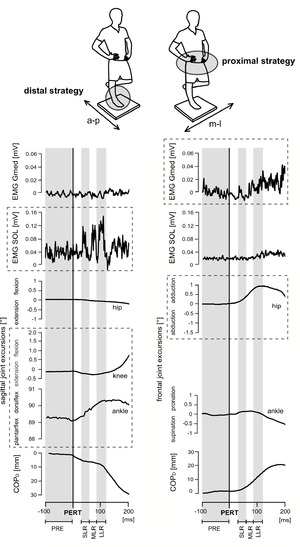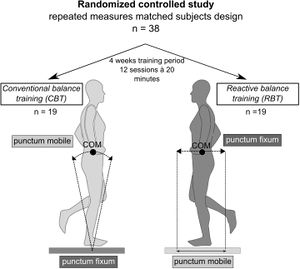Reactive Balance: Intervention Strategies: Difference between revisions
No edit summary |
No edit summary |
||
| Line 5: | Line 5: | ||
</div> | </div> | ||
== Description == | == Description == | ||
[[File:Reactive-balance-posterior-lateral-perturbation.png|left|thumb|Reactive Balance]] | |||
The biggest goal when working with people who demonstrate unstable gait or fear of falling is to help them learn how to control their [[Base of support|center of gravity]]. Traditionally the framework for interventions was viewed as incorporating static or dynamic [[balance]] interventions. When determining interventions to improve balance and stability, you can now begin to become more detailed in your thought processes. You can incorporate [[Anticipatory Adjustments: Balance Strategy|anticipatory adjustments]] in your balance intervention strategy. You can include reactive balance intervention strategies. Reactive balance is different than anticipatory adjustments because the patient is not aware and cannot plan for the upcoming situation. The patient's body has to immediately take action and react without any planning. <ref>Freyler K, Gollhofer A, Colin R, Brüderlin U, Ritzmann R. [https://journals.plos.org/plosone/article?id=10.1371/journal.pone.0144529 Reactive Balance Control in Response to Perturbation in Unilateral Stance: Interaction Effects of Direction, Displacement and Velocity on Compensatory.] Neuromuscular and Kinematic Responses. PLoS ONE 2015;12:0144529. </ref> | |||
== Indication == | == Indication == | ||
| Line 17: | Line 17: | ||
== Resources == | == Resources == | ||
This is a study that includes a small n value for a randomized controlled trial comparing conventional balance training on a surface that is unstable but is targeted to have postural sway responses mainly involving the ankle joint (ankle strategies) to reactive balance training where the support surface is moved underneath the feet.<ref>Krause A, Freyler K, Gollhofer A, Stocker T, Bruederlin U, Colin R, Toepfer H, Ritzmann R. [https://www.ncbi.nlm.nih.gov/pubmed/30131722 Neuromuscular and kinematic adaptation in response to reactive balance training–a randomized controlled study regarding fall prevention.] Frontiers in Physiology. 2018;9:1075.</ref> | |||
One image in the above study really connected with me to help better understand what is meant by reactive balance training. As you can see, the support surface is moved underneath the person and the person has to respond to that perturbation. | |||
[[File:Reactive-balance-training.jpg|center|thumb|Reactive Balance Training]] | |||
When we begin talking about reactive balance intervention strategies, these types of strategies require some equipment in order to create a situation where the ground is moving under the feet. Let me first share a few of my own videos on various ways to provide reactive balance interventions. | |||
{| width="100%" cellspacing="1" cellpadding="1" | |||
|- | |||
|{{#ev:youtube|FM1eDrApucg|300}} <ref>Red Cedar Physical Therapy, LLC. 1st Time on Shuttle Balance. Available from: https://www.youtube.com/watch?v=FM1eDrApucg</ref> | |||
|{{#ev:youtube|86Tbuv_i__0|300}}<ref> Red Cedar Physical Therapy, LLC. Shuttle Balance: Close up Walking Up and Down Ramp. Available from: https://www.youtube.com/watch?v=86Tbuv_i__0</ref> | |||
|} | |||
add appropriate resources here, including text links or content demonstrating the intervention or technique | add appropriate resources here, including text links or content demonstrating the intervention or technique | ||
Revision as of 23:06, 12 February 2019
Original Editor - Selena Horner
Top Contributors - Selena Horner, Kim Jackson and Lucinda hampton
Description[edit | edit source]
The biggest goal when working with people who demonstrate unstable gait or fear of falling is to help them learn how to control their center of gravity. Traditionally the framework for interventions was viewed as incorporating static or dynamic balance interventions. When determining interventions to improve balance and stability, you can now begin to become more detailed in your thought processes. You can incorporate anticipatory adjustments in your balance intervention strategy. You can include reactive balance intervention strategies. Reactive balance is different than anticipatory adjustments because the patient is not aware and cannot plan for the upcoming situation. The patient's body has to immediately take action and react without any planning. [1]
Indication[edit | edit source]
add text here relating to the indication for the intervention
Clinical Presentation[edit | edit source]
add text here relating to the clinical presentation of the condition, including pre- and post- intervention assessment measures.
Resources[edit | edit source]
This is a study that includes a small n value for a randomized controlled trial comparing conventional balance training on a surface that is unstable but is targeted to have postural sway responses mainly involving the ankle joint (ankle strategies) to reactive balance training where the support surface is moved underneath the feet.[2]
One image in the above study really connected with me to help better understand what is meant by reactive balance training. As you can see, the support surface is moved underneath the person and the person has to respond to that perturbation.
When we begin talking about reactive balance intervention strategies, these types of strategies require some equipment in order to create a situation where the ground is moving under the feet. Let me first share a few of my own videos on various ways to provide reactive balance interventions.
| [3] | [4] |
add appropriate resources here, including text links or content demonstrating the intervention or technique
References[edit | edit source]
- ↑ Freyler K, Gollhofer A, Colin R, Brüderlin U, Ritzmann R. Reactive Balance Control in Response to Perturbation in Unilateral Stance: Interaction Effects of Direction, Displacement and Velocity on Compensatory. Neuromuscular and Kinematic Responses. PLoS ONE 2015;12:0144529.
- ↑ Krause A, Freyler K, Gollhofer A, Stocker T, Bruederlin U, Colin R, Toepfer H, Ritzmann R. Neuromuscular and kinematic adaptation in response to reactive balance training–a randomized controlled study regarding fall prevention. Frontiers in Physiology. 2018;9:1075.
- ↑ Red Cedar Physical Therapy, LLC. 1st Time on Shuttle Balance. Available from: https://www.youtube.com/watch?v=FM1eDrApucg
- ↑ Red Cedar Physical Therapy, LLC. Shuttle Balance: Close up Walking Up and Down Ramp. Available from: https://www.youtube.com/watch?v=86Tbuv_i__0








